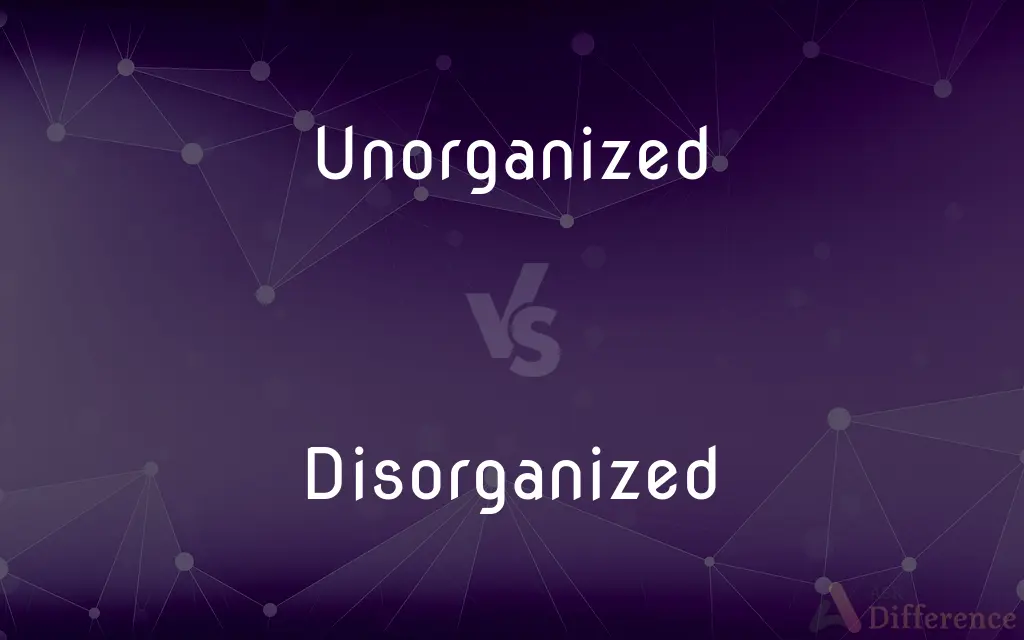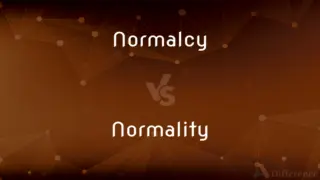Unorganized vs. Disorganized — What's the Difference?
By Tayyaba Rehman & Maham Liaqat — Updated on March 20, 2024
Unorganized refers to lacking a formal structure or system, while disorganized implies a state of confusion and lack of order within an existing system.

Difference Between Unorganized and Disorganized
Table of Contents
ADVERTISEMENT
Key Differences
Unorganized is used to describe something that lacks any sort of organization or structure from the outset. It's about the absence of a system or order in a general sense. For instance, a group of people who gather spontaneously without a leader or agenda is unorganized. On the other hand, disorganized describes a situation or entity that was supposed to have order but currently exhibits chaos or mess. It suggests a failure to maintain organization, like a cluttered desk that was once tidy.
When considering entities or groups, being unorganized means there's no underlying system or preconceived structure governing actions or arrangements. This can apply to groups without leaders, events without schedules, or files without categorization. Whereas being disorganized points to a lapse in maintaining an existing structure, such as a team failing to follow through with its project management system or a person struggling to keep their appointments in order.
An unorganized state might not necessarily impede functionality if the situation doesn’t require structure. For example, a casual meetup of friends can proceed smoothly without an agenda. Disorganized scenarios, however, often result in inefficiency and confusion because there's an expectation of order that is not met, such as when a business meeting lacks a clear agenda, leading to unproductive discussions.
The term unorganized also implies a potential for organization; it’s a blank slate. In contrast, disorganized indicates a departure from or corruption of an intended order, requiring reorganization to restore functionality. This distinction highlights the proactive approach needed to address disorganization versus the neutral or formative state of being unorganized.
While unorganized can sometimes be intentional or neutral, reflecting a choice or a preliminary stage, disorganization is generally viewed negatively. It signifies a breakdown or failure in a system that ideally should function smoothly. For example, an unorganized group might simply be in the early stages of forming its structure, while a disorganized group has likely lost its way from an established protocol.
ADVERTISEMENT
Comparison Chart
Definition
Lacking formal structure or order from the outset.
Exhibiting confusion and lack of order in an existing system.
Nature
Neutral or formative.
Negative, implying chaos within a supposed structure.
Requirement for Action
May not require immediate action; potential for future organization.
Necessitates action to restore order and functionality.
Impact
Can operate without immediate issues if structure is not required.
Leads to inefficiency and confusion due to failed expectations.
Example Contexts
Groups without leaders, events without schedules.
Cluttered workspaces, ineffective meeting management.
Compare with Definitions
Unorganized
Not formally structured or categorized.
Her collection of books was unorganized, spread throughout her home.
Disorganized
Exhibiting confusion and inefficiency.
The event was disorganized, leading to delays and frustrated attendees.
Unorganized
Without a cohesive or systematic approach.
The community meeting was unorganized, lacking a clear agenda.
Disorganized
Failing to maintain order or organization.
His disorganized desk made it difficult to find important documents.
Unorganized
Lacking structured arrangement or system.
The new volunteers were unorganized, having no assigned roles yet.
Disorganized
Characterized by a lack of coherent structure or order.
The project team was disorganized, missing deadlines frequently.
Unorganized
Absence of predetermined order or system.
The discussion was unorganized, with topics changing randomly.
Disorganized
Reflecting chaos within a supposed system.
The filing system was disorganized, with files misplaced or lost.
Unorganized
Not governed by an organizing principle.
The store’s stock was unorganized, making it hard to find specific items.
Disorganized
Departure from an expected or established order.
Her schedule became disorganized, causing overlaps and missed appointments.
Unorganized
Lacking order, unity, or a system; disorganized.
Disorganized
To destroy the organization, systematic arrangement, or unity of.
Unorganized
Having no organic qualities; inorganic.
Disorganized
Simple past tense and past participle of disorganize
Unorganized
Not represented by a labor union.
Disorganized
Lacking order or organization; confused; chaotic.
Unorganized
Not organized: not having been organized.
Disorganized
Lacking skills for organizing one's affairs.
He is quite disorganized and has difficulty planning his day or remembering when his homework is due.
Unorganized
(of a territory) Lacking a normal system of government.
Palmyra Atoll is an unorganized territory.
Disorganized
(psychology) In a state of disruption of orderly psychological functioning; engaging in behaviour that is chaotic, self-contradictory, or out of keeping with reality; (of a mental illness) poorly controlled and leading to a disorganized state.
Unorganized
Not unionized.
Disorganized
Lacking order or methodical arrangement or function;
A disorganized enterprise
A thousand pages of muddy and disorganized prose
She was too disorganized to be an agreeable roommate
Unorganized
Not having or belonging to a structured whole;
Unorganized territories lack a formal government
Unorganized
Not affiliated in a trade union;
The workers in the plant were unorganized
Common Curiosities
Why is disorganization considered negative?
Because it signifies a failure to meet the expectations of order and efficiency within an existing system.
What does unorganized mean?
Unorganized refers to the lack of a formal structure, system, or order from the beginning.
Can something be both unorganized and disorganized?
Typically, something starts as unorganized and becomes disorganized if it fails to establish or maintain intended order.
Can disorganization affect mental health?
Yes, living or working in a disorganized environment can increase stress and anxiety.
Does being unorganized affect productivity?
It can, depending on the context and whether a structured system is necessary for the task or goal at hand.
Is being unorganized always a negative state?
Not necessarily; being unorganized can be neutral or simply reflect a formative stage.
What strategies help maintain organization?
Regular reviews, decluttering, adherence to systems, and adjustment of processes to fit current needs.
How does disorganized differ from unorganized?
Disorganized implies a state of confusion and lack of order within an entity that should have an existing system.
What are the consequences of being disorganized?
Consequences include inefficiency, confusion, stress, and potentially missing out on important tasks or deadlines.
Is it easier to organize something that is unorganized or disorganized?
Organizing something unorganized is generally easier because it doesn’t require correcting existing chaos, just creating structure.
Can technology help with organization?
Yes, various tools and apps are designed to help individuals and groups stay organized and manage tasks effectively.
How can one address disorganization?
By implementing or restoring effective systems and processes to manage chaos and improve functionality.
What role does leadership play in preventing disorganization?
Leadership is crucial in setting expectations, providing direction, and ensuring adherence to organizational systems.
How can one develop better organizational skills?
Through practice, learning from organized individuals, and using tools and systems that enhance order and efficiency.
How can a group transition from unorganized to organized?
Through the establishment of clear roles, rules, and processes that structure interaction and tasks.
Share Your Discovery

Previous Comparison
Normalcy vs. Normality
Next Comparison
Xenograft vs. HeterograftAuthor Spotlight
Written by
Tayyaba RehmanTayyaba Rehman is a distinguished writer, currently serving as a primary contributor to askdifference.com. As a researcher in semantics and etymology, Tayyaba's passion for the complexity of languages and their distinctions has found a perfect home on the platform. Tayyaba delves into the intricacies of language, distinguishing between commonly confused words and phrases, thereby providing clarity for readers worldwide.
Co-written by
Maham Liaqat















































